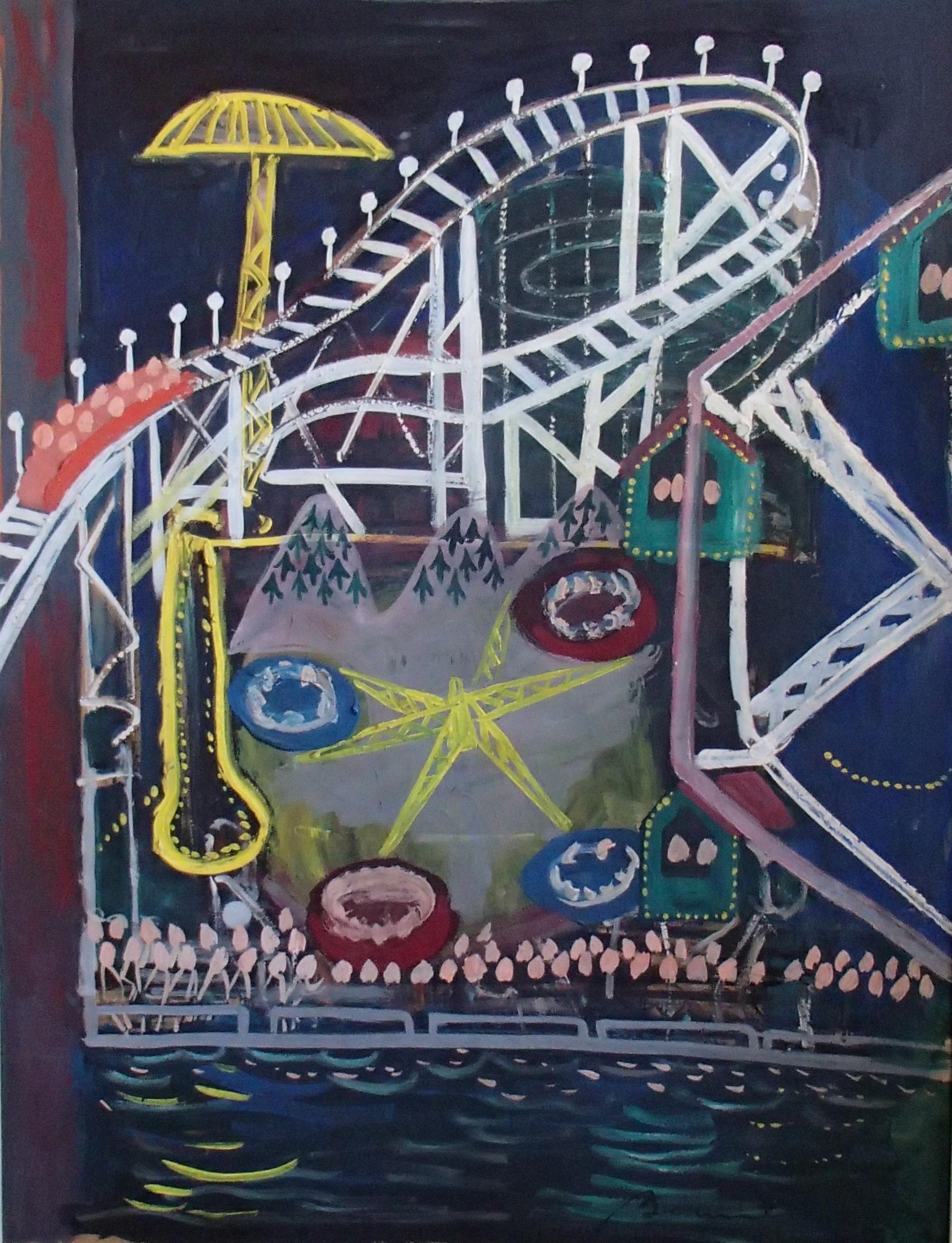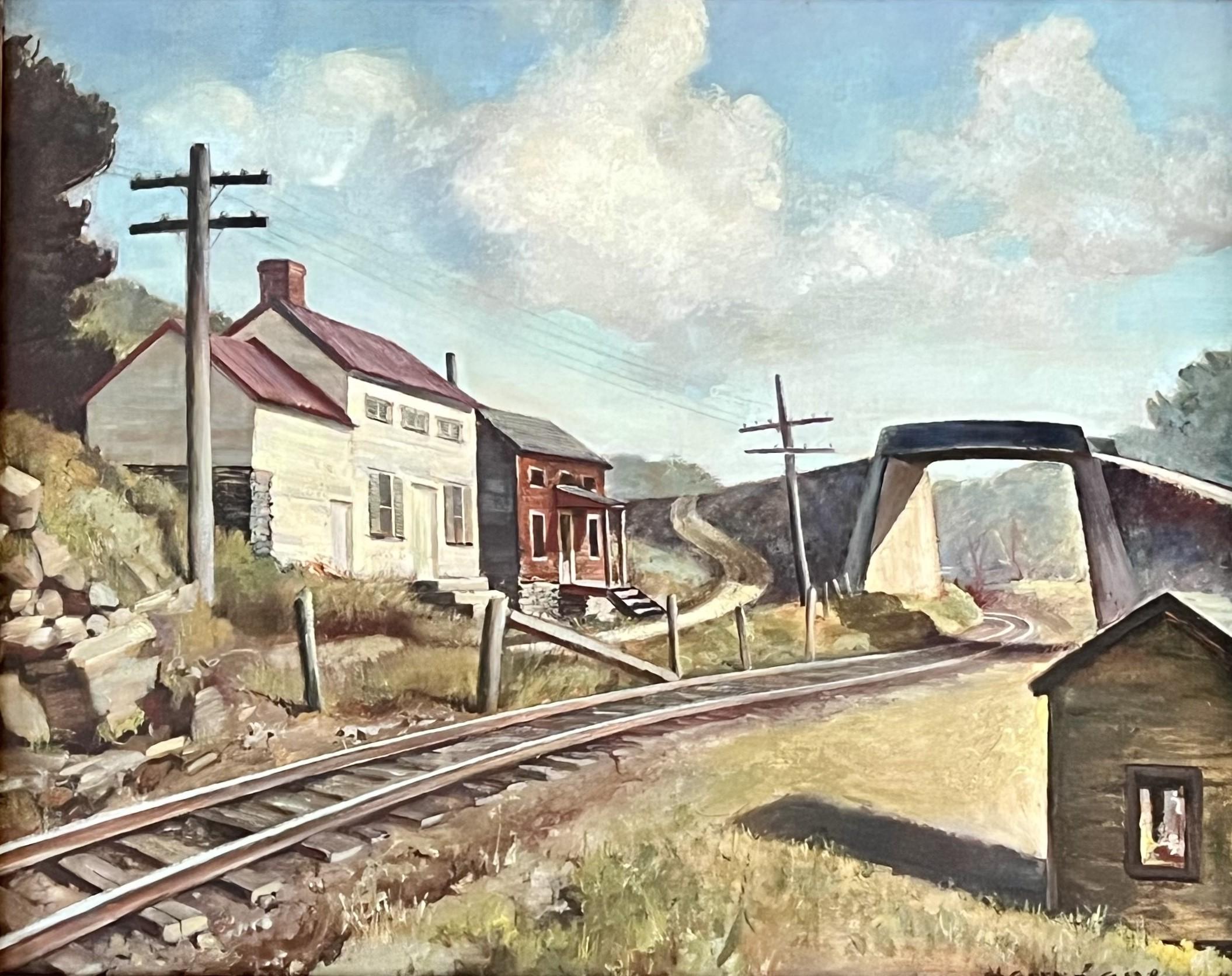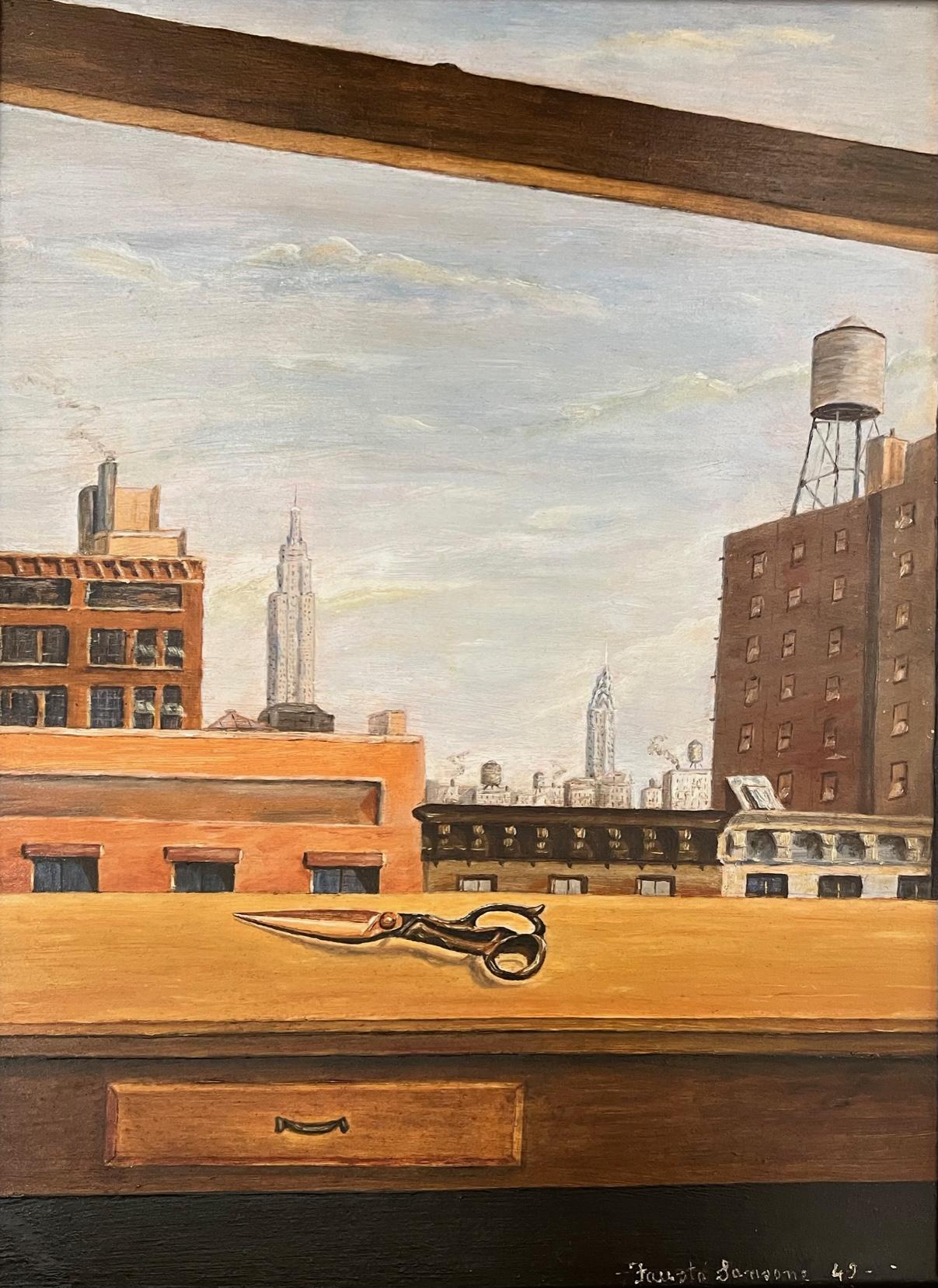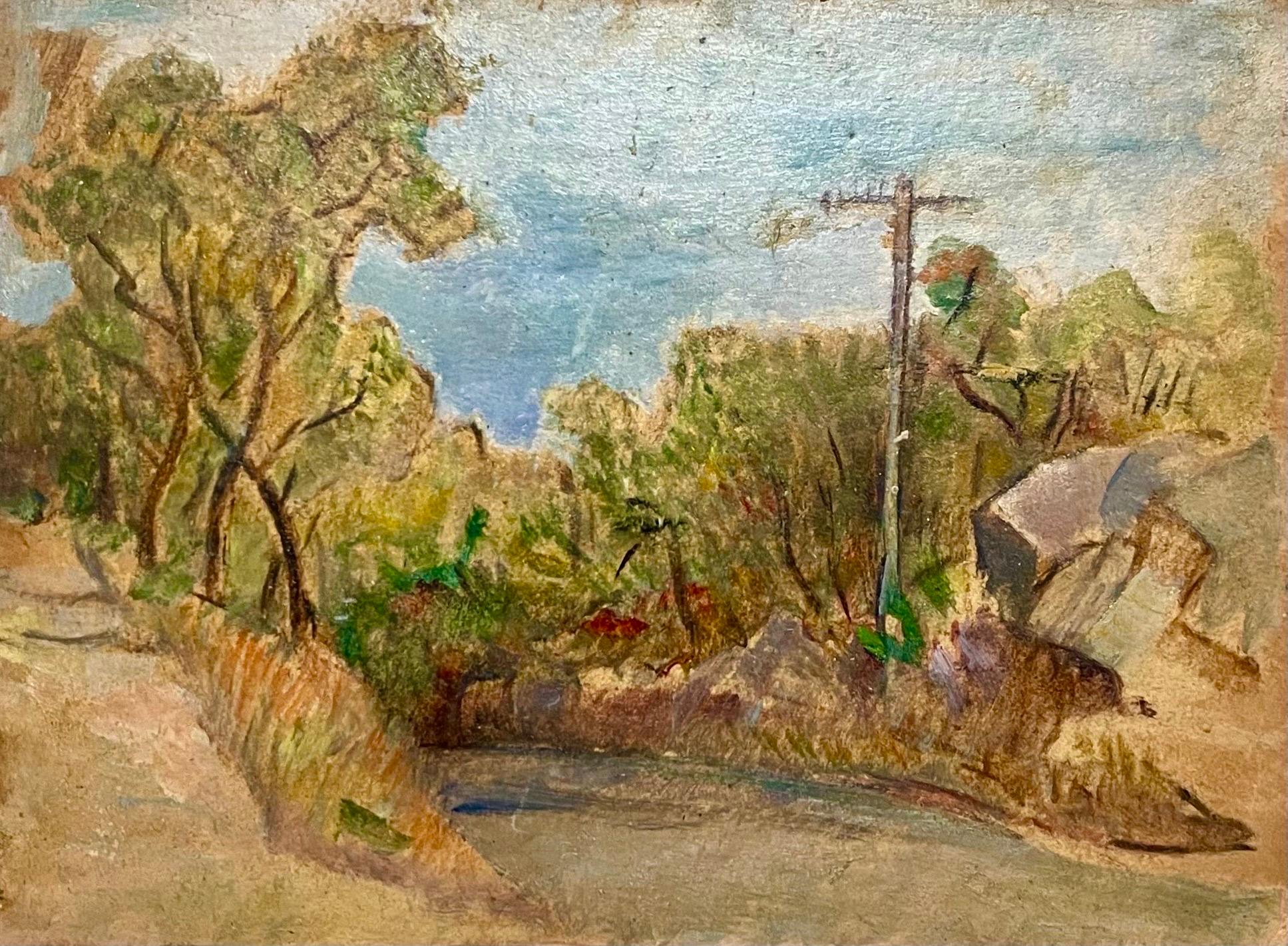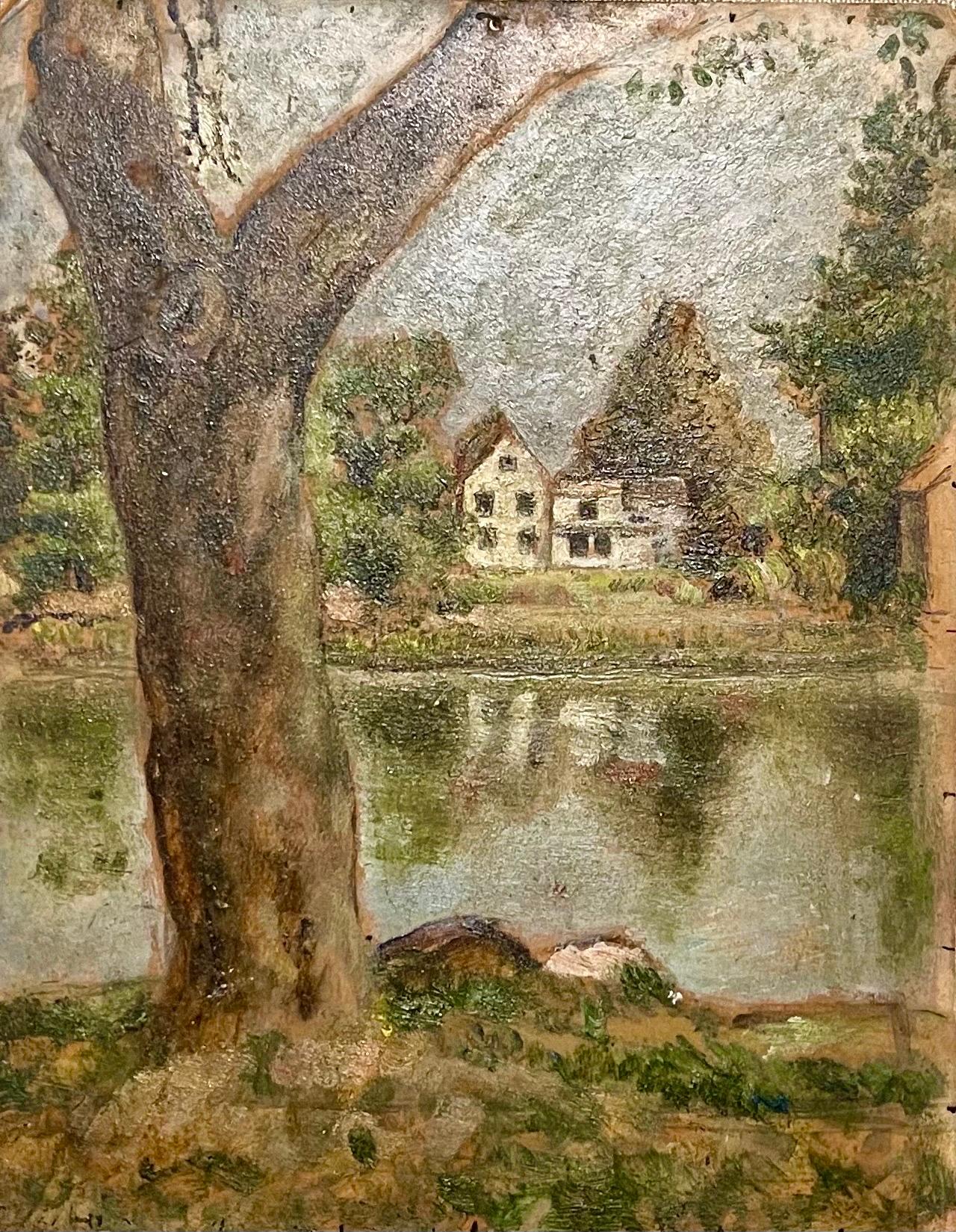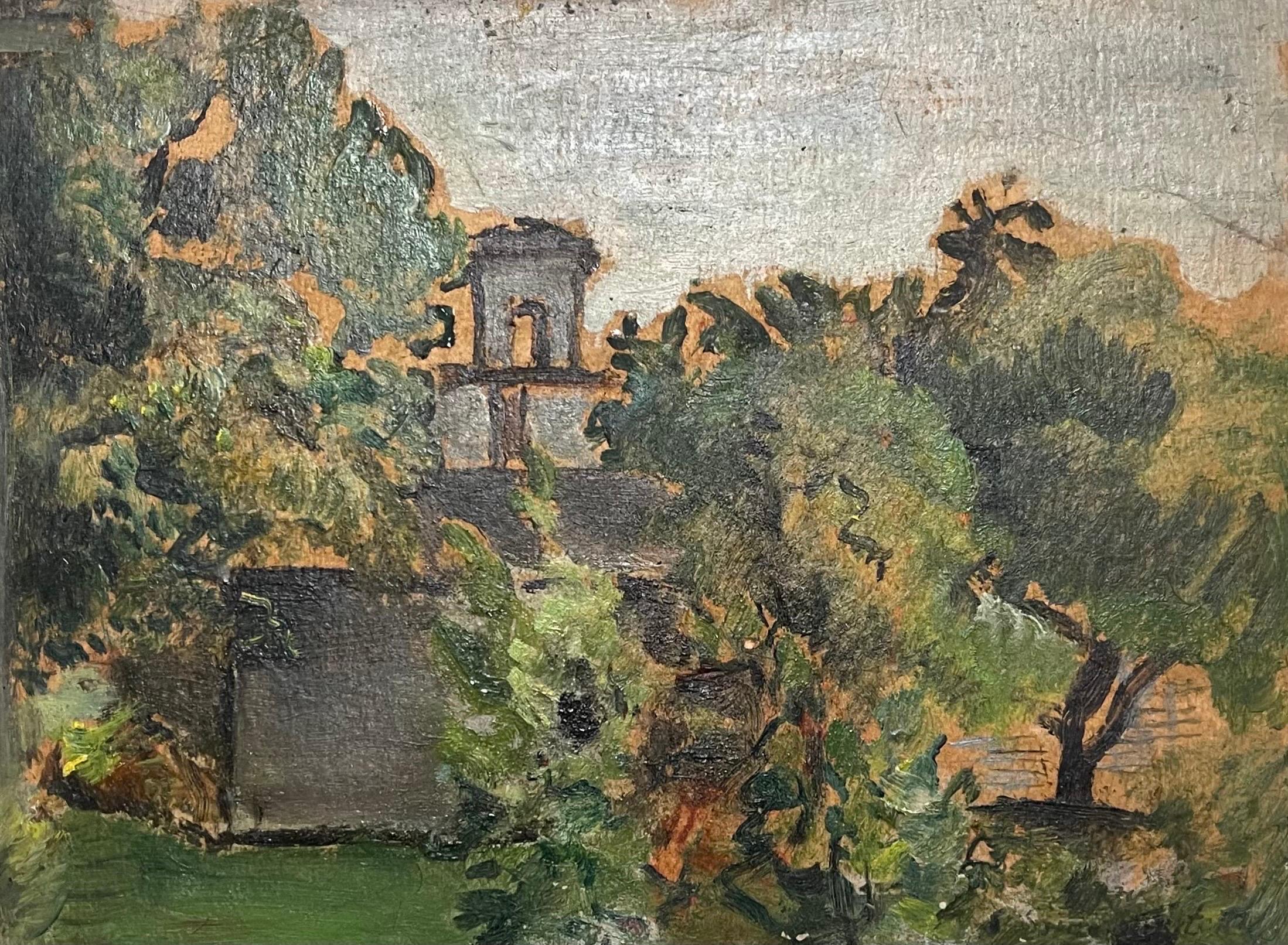Items Similar to Pueblo Near Santa Fe, New Mexico, 1930s Southwestern Landscape Oil Painting
Video Loading
Want more images or videos?
Request additional images or videos from the seller
1 of 17
Eliot Candee ClarkPueblo Near Santa Fe, New Mexico, 1930s Southwestern Landscape Oil Painting1932
1932
About the Item
Oil on board landscape painting of a Pueblo near Santa Fe, New Mexico signed by artist Eliot Candee Clark (1883-1980), painted in 1932. Signed by the artist in the lower left corner. Composed of shades of brown, tan, and blue. Presented in a custom frame, outer dimensions measure 23 ½ x 25 x 1 3⁄4 inches. Image size is 17 1⁄4 x 19 1⁄2 inches.
About the Artist:
Son of landscape painter Walter Clark and Jennifer Woodruff Clark, a student of psychic phenomena, Eliot Clark was a precocious artist who became a landscape painter in the late American Impressionist style. Moving to Albemarle, Virginia in 1932, he was one of the few Impressionist artists of the Southern states. Likely this was a result of his association with James Whistler and his painting in 1900 at Gloucester, Massachusetts with John Twachtman, a family friend. Showing his obvious interest in Impressionism, he wrote a book about its exponents including Twachtman, Theodore Robinson, Childe Hassam, Julian Weir, and Robert Vonnoh.
Clark was a teacher including at the National Art Club from 1943, the Art Students League, and New York City College.
Early in his youth, Clark traveled with his father and other prominent artists to paint in the summer art colonies at Annisquam, Gloucester, Chadd's Ford and Ogunquit where he met artists of stature such as Edward Potthast and John Henry Twachtman. Clark's only formal instruction was a short two months at the Art Students League in New York.
His landscapes evoked a "spiritualized rendition of nature" that was to stay with him for the rest of his life. Clark (perhaps related to his mother's interest in physic phenomena) developed an early interest in oriental philosophy that ended up having a major effect on his artistic development, the sense of spirituality in his landscape paintings slowly grew in importance.
Clark was educated in the New York public schools, and at age 13 exhibited with the National Academy and the New York Water Color Club. By 1912, he had won national painting awards, and by 1916 was writing books on American artists as well as the history of the National Academy. In his early years Clark was privately tutored, and then later graduated from Washington Irving High School at the early age of fifteen. Although he later was quoted as saying "he had no formal training from his father", his early work was notable influenced by Walter Clark's tonalist style.
Between 1904 and 1906, Clark studied in France in Paris and Giverny, and in London he saw the impressionist work of James Whistler. He wrote to his father about the Whistler Exhibit stating that some of Whistler's work impressed him, "not so much in the handling, but in the use of
color, and subtle arrangement of line and balance of masses." He engaged in a "walking tour" of Europe with a fellow artist whom he met in earlier in Paris. They visited many of the major galleries in Holland and then traveled through the Alps, finally reaching Venice on August 10, 1906. I n Venice, he produced some Whistlerian style pastels similar to the ones he had seen in the Whistler Exhibition.
He returned to New York in 1906, and a year later took a studio in the Van Dyke Studio Building on Eighth Avenue. There working in the building were a diversified group of painters such as the tonalist artists Bruce Crane and Cullan Yates; the impressionists were represented by Edward Dufner and Karl Anderson.
In 1912, he painted at the Grand Canyon, in New Mexico, the Painted Desert and northern Arizona, and in 1913, he was in California, painting in Yosemite.
In the 1920s and 1930s, he again painted landscapes in the Southwest including the Arizona Painted Desert in 1926 and 1935. From 1922 to 1932, he lived primarily in Kent, Connecticut along the Housatonic river with such notable impressionist painters as Robert Nesbet and G. Glenn Newell. In 1932, he moved to Albemarle County Virginia to escape from a bitter divorce with his first wife. This led to a dark time for Clark who opted to travel abroad to find himself again rather than take the security of a teaching position, which was offered to him by the University of Georgia.
Because of his interest in eastern philosophy he traveled in the late 1930s to India for two years where he painted the Himalayas and also to Tibet. He also painted in the Deep South in Charleston and Savannah where he set up his easel on the waterfronts and among oak groves. In 1944 rejuvenated by a second marriage and election to the National Academy of Design, Clark returned to the Connecticut countryside to paint landscapes. In the late 1940s Clark began to summer in Virginia where he ultimately returned for good in 1959, settling with his new wife in the "lovely hills" near Albemarle, Virginia.
He continued to paint almost to the end of his life, enjoying the solitude and peace of the surrounding environment where he could relate to canvas the subtleties of nature as only he could. He was elected an associate member of the National Academy of Design in 1917 and full academician in 1944. Clark was also president of the National Academy from 1956-1959. He was a member/president of the American Watercolor Society; president/member of Allied Artists of America, 1948-52; ex officio trustee, Metropolitan Museum of Art, 1956; National Academy of Design Awards Jury; Society of Painters of New York; Connecticut Association of Fine Art; Salmagundi Club; International Society of Arts and Letters; Macdonald Club; Art Fund Society; New York Watercolor Club and others.
Clark exhibited at the New York Watercolor Club; National Academy of Design; American Art Association of Paris Annual Exhibition; Doll & Richards, Boston; Louis Katz Gallery, NY; Guild of Allied Artists, NY; Milwaukee Art Institute; Henry Reinhardt & Son, NY; Mohr Art Galleries; Butler Art Institute; Telfair Academy, Georgia; Rochester Art Association, Rochester, MN; J.W. Young Galleries; Atlanta Woman's Club; Fort Worth Museum of Art, Texas; Carnegie Public Library; Providence Art Club; Witt Memorial Museum, Texas; Nan Sheets Gallery, Oklahoma; Iran Institute and others.He taught at the Art Students'League; Savannah Art club; University of Virginia; Grand Central Art Gallery School and others.
Eliot Candee Clark passed away in 1980.
- Creator:Eliot Candee Clark (1883 - 1980)
- Creation Year:1932
- Dimensions:Height: 23.5 in (59.69 cm)Width: 25 in (63.5 cm)Depth: 1.75 in (4.45 cm)
- Medium:
- Movement & Style:
- Period:
- Framing:Frame IncludedFraming Options Available
- Condition:very good to excellent condition.
- Gallery Location:Denver, CO
- Reference Number:
About the Seller
5.0
Platinum Seller
These expertly vetted sellers are 1stDibs' most experienced sellers and are rated highest by our customers.
Established in 1979
1stDibs seller since 2013
265 sales on 1stDibs
Typical response time: 3 hours
- ShippingRetrieving quote...Ships From: Denver, CO
- Return PolicyA return for this item may be initiated within 7 days of delivery.
More From This SellerView All
- Homesteaders, 1960s Framed Colorado Mountain Landscape Oil PaintingBy Harold Vincent SkeneLocated in Denver, CO"Homesteaders" is an original oil on board painting by artist Harold Vincent Skene (1883-1978) painted in 1960. The painting depicts two figures plowing a field with a pair of oxen, ...Category
1960s American Modern Landscape Paintings
MaterialsOil, Board
- Mountain Sunset, Colorado, Vintage 1950s Autumn Landscape Painting with RiverBy Harold Vincent SkeneLocated in Denver, COOil on board painted in 1958 by Harold Vincent Skene (1883-1978) titled 'Mountain Sunset'. Colorado mountain autumn landscape featuring changing leaves...Category
Mid-20th Century American Modern Landscape Paintings
MaterialsBoard, Oil
- Near Watsonville, California, Mid Century Landscape Oil Painting House TreesBy Jon BlanchetteLocated in Denver, COMid 20th Century oil on artist board of a white house near Watsonville, California. 1950s landscape painting with house and trees. Presented in a...Category
Mid-20th Century American Modern Landscape Paintings
MaterialsBoard, Oil
- Storm Over Victor (Colorado Mountain Town), 1940s WPA Era Landscape Oil PaintingLocated in Denver, COOil on board painting by George Vander Sluis (1915-1984) titled Storm Over Victor (Colorado Mountain Town) from 1946. WPA Era Mountain Landscape wi...Category
1940s American Modern Landscape Paintings
MaterialsBoard, Oil
- Southwestern Landscape Painting, Lightning Storm over Mountains, Semi AbstractLocated in Denver, COOriginal vintage painting of a Lightning Storm, Southwestern Mountain Landcape. Oil painting on textured board by Morton Lawrence Schneider (1919-2000). This large scale semi abstrac...Category
20th Century American Modern Landscape Paintings
MaterialsOil, Board
- Twilight of History, Figurative American Modernist Oil Painting, Gold Green RedBy Frederick ShaneLocated in Denver, CO"Twilight of History" is an original oil on board painting by Frederick Shane (1906-1992) from 1947. Shane's reflection of the twilight of our existence is shown with three creatures...Category
1940s American Modern Figurative Paintings
MaterialsBoard, Oil
You May Also Like
- "Coney Island" Brooklyn NYC Amusement Park Mid-century American Scene WPA ModernBy Ludwig Bemelmans, 1898-1962Located in New York, NY"Coney Island" Brooklyn NYC Amusement Park Mid-century American Scene WPA Modern Ludwig Bemelmans (1898 – 1962), “Coney Island" 35 x 27 inches Oil on board Signed lower left Origin...Category
1940s American Modern Landscape Paintings
MaterialsOil, Board
- Untitled (Houses and Railroad Tracks)By Harry LaneLocated in Los Angeles, CAUntitled (Houses and Railroad Tracks), c. 1940s, oil on canvas board, signed lower right, 16 x 20 inches, presented in a newer frame This work is part of our exhibition America Coas...Category
1940s American Modern Paintings
MaterialsOil, Board
- My Only Working ToolLocated in Los Angeles, CAMy Only Working Tool, 1949, oil on panel, signed and dated lower right, 16 x 12 inches, remnant of exhibition label verso, exhibited at the Art News Second Annual National Amateur Co...Category
1940s American Modern Paintings
MaterialsOil, Board
- Large Modernist Oil Painting 1940s, Judaica Hasidic Shtetl Wagon Driver WPA EraBy Emanuel Glicenstein RomanoLocated in Surfside, FLGenre: Modern Subject: Landscape with figure of horse, driver and wagon Medium: Oil Surface: wood Board EMANUEL ROMANO Rome, Italy, b. 1897, d. 1984 Emanuel Glicen Romano was born in Rome, September 23, 1897. His father Henryk Glicenstein was a sculptor and was living in Rome with his wife Helena (born Hirszenberg) when Emanuel was born. His father obtained Italian citizenship and adopted the name Enrico. Emanuel was brought up in Italy, Switzerland, Germany, England and Poland. In 1926 Emanuel Glicenstein Romano and his father sailed for New York. They briefly visited Chicago. Romano's sister, Beatrice, and mother only joined them in New York years later. Romano changed his name on his arrival to America and some have erroneously speculated that this was to avoid antisemitic discrimination. In truth, as the son of a highly-regarded artist, Romano changed his name to ensure that any success or recognition he would later attain, would be the result of nothing other than his own merit as an artist, and not on account of his father's fame. In 1936 Romano was worked for the WPA Federal Art Project creating murals. ( there were many jewish artists active with in the WPA period. notably Chaim Gross, Ben Shahn, Isaac and Moses Soyer, Abraham Rattner and many others. During and immediately after World War II, Romano created a series of allegorical works depicting graphic holocaust images that were held closely by the family until after his passing. One of these works is now on permanent display in the Florida Holocaust Museum in St. Petersburg Florida. Emanuel's father died in 1942 in a car accident before they could realize their shared dream of visiting Israel. In 1944 Romano, having completed his degree at the Pennsylvania Academy of Fine Arts and the Art Institute of Chicago, began teaching at the City College of New York. Romano moved to Safed, Israel in 1953 and established an art museum in his father's memory, the Glicenstein Museum. COLLECTIONS Indianapolis Museum of Art Metropolitan Museum of Art Boston Fine Arts Museum Fogg Museum Musée Nacional de France Recently his work has been added to the Florida Holocaust Museum collection. His notable works include his holocaust themed allegorical paintings as well as portraits of Marianne Moore, his father and William Carlos Williams...Category
1930s American Modern Figurative Paintings
MaterialsOil, Board
- Simka Simkhovitch WPA Artist Oil Painting Gouache American Modernist PowerlineBy Simka SimkhovitchLocated in Surfside, FLSimka Simkhovitch (Russian/American 1893 - 1949) This came with a small grouping from the artist's family, some were hand signed some were not. These were studies for larger paintings. Simka Simkhovitch (Симха Файбусович Симхович) (aka Simka Faibusovich Simkhovich) (Novozybkov, Russia May 21, 1885 O.S./June 2, 1885 N.S.—Greenwich, Connecticut February 25, 1949) was a Ukrainian-Russian Jewish artist and immigrant to the United States. He painted theater scenery in his early career and then had several showings in galleries in New York City. Winning Works Progress Administration (WPA) commissions in the 1930s, he completed murals for the post offices in Jackson, Mississippi and Beaufort, North Carolina. His works are in the permanent collections of the Dallas Museum of Art, the National Museum of American Art and the Whitney Museum of American Art. Born outside Kyiv (Petrograd Ukraine) into a Jewish family who owned a small department store. During a severe case of measles when he was seven, Simcha Simchovitch sketched the views outside his window and decided to become an artist, over his father's objections. Beginning in 1905, he studied at the Grekov Odessa Art School and upon completion of his studies in 1911 received a recommendation to be admitted to the Imperial Academy of Arts. Though he enrolled to begin classes in architecture, painting, and sculpture at the Imperial Academy, he was dropped from the school roster in December because of the quota on the number of Jewish students and drafted into the army. Simchovitch served as a private in the 175th Infantry Regiment Baturyn [ru] until his demobilization in 1912. Re-enrolling in the Imperial Academy, he audited classes. Simka Simkhovitch exhibited paintings and sculptures in 1918 as part of an exhibition of Jewish artists and in 1919 placed 1st in the competition "The Great Russian Revolution" with a painting called "Russian Revolution" which was hung in the State Museum of Revolution. In 1922, Simkha Simkhovitch exhibited at the International Book Fair in Florence (Italian: Fiera Internazionale del Libro di Firenze). In 1924, Simkhovitch came to the United States to make illustrations for Soviet textbooks and decided to immigrate instead. Initially he supported himself by doing commercial art and a few portrait commissions. In 1927, he was hired to paint a screen for a scene in the play "The Command to Love" by Fritz Gottwald and Rudolph Lothar which was playing at the Longacre Theatre on Broadway. Art dealers began clamoring for the screen and Simkhovitch began a career as a screen painter for the theater. Catching the attention of the screenwriter, Ernest Pascal, he worked as an illustrator for Pascal, who then introduced him to gallery owner, Marie Sterner. Simkhovitch's works appeared at the Marie Sterner Gallery beginning with a 1927 exhibit and were repeated the following year. Simkhovitch had an exhibit in 1929 at Sterner's on circus paintings. In 1931, he held a showing of works at the Helen Hackett Gallery, in New York City and later that same year he was one of the featured artists of a special exhibit in San Francisco at the California Palace of the Legion of Honor in Lincoln Park. The exhibit was coordinated by Marie Sterner and included four watercolors, including one titled "Nudes". He is of the generation of Russian Soviet artists such as Isaac Pailes, Serge Charchoune, Marc Chagall, Chana Orloff, Isaac Ilyich Levitan, and Ossip Zadkine. In 1936, Simkhovitch was selected to complete the mural for the WPA Post office project in Jackson, Mississippi. The mural was hung in the post office and courthouse in 1938 depicted a plantation theme. Painted on the wall behind the judge’s bench, “Pursuits of Life in Mississippi”, a depiction of black workers engaged in manual labor amid scenes of white professionals and socialites, was eventually covered over in later years during renovations due to its stereotypical African American imagery. Simka painted what he thought was typical of Jackson. His impression of pre-civil rights Mississippi was evidently Greek Revival column houses, weeping willow trees, working class families, and the oppression of African Americans. He painted African American men picking cotton, while a white man took account of the harvest and a white judge advised a white family, calling it Pursuits of Life in Mississippi. Though clearly endorsed by the government and initially generally well-received, the mural soon raised concerns with locals as the climate toward racial segregation began to change. The main concern was whether depictions that show African Americans in subjugated societal roles should be featured in a courtroom. The following year, his painting "Holiday" won praise at an exhibition in Lincoln, Nebraska. In 1940, Simkhovitch's second WPA post office project was completed when four murals, "The Cape Lookout Lighthouse and the Orville W. Mail Boat", "The Wreck of the Crissie Wright", "Sand Ponies" and "Canada Geese" were installed in Beaufort, North Carolina. The works were commissioned in 1938 and did not generate the controversy that the Jackson mural had. The main mural is "The Wreck of the Crissie Wright" and depicts a shipwreck which had occurred in Beaufort in 1866. "The Cape Lookout Lighthouse and the Orville W. Mail Boat" depicted the lighthouse built in 1859 and the mail boat that was running mail during the time which Simkhovitch was there. The boat ran mail for the area until 1957. "Sand Ponies" shows the wild horses common to the North Carolina barrier islands and "Canada Geese" showed the importance of hunting and fishing in the area. All four murals were restored in the 1990s by Elisabeth Speight, daughter of two other WPA muralists, Francis Speight...Category
1930s American Modern Landscape Paintings
MaterialsGouache, Oil, Board
- Simka Simkhovitch WPA Artist Oil Painting American Modernist Landscape Pond TreeBy Simka SimkhovitchLocated in Surfside, FLSimka Simkhovitch (Russian/American 1893 - 1949) This came with a small grouping from the artist's family, some were hand signed some were not. Thes...Category
1930s American Modern Landscape Paintings
MaterialsOil, Board
Recently Viewed
View AllMore Ways To Browse
New Mexico Landscape Painting
Grand New York Paintings
Oil Canvas Mexico
Mexican Oil Canvas Painting
Connecticut Landscape Painting
Worth New York
Santa Fe New Mexico
Santa Fe Art Galleries
Santa Fe Gallery
New Mexico Landscape Oil
New Mexico Landscape Oil Paintings
New York City 1920s
Desert New Mexico
Mexico Oil Painters
Landscape Oil Boston
South American Landscape Paintings
Boston Landscape Oil Painting
Mexico Travel
